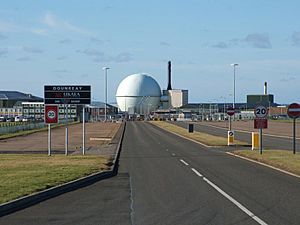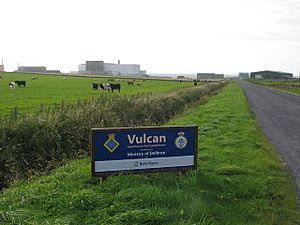Dounreay facts for kids
Dounreay ( Scottish Gaelic: Dùnrath) is a small place on the north coast of Caithness in Scotland. It's famous for being home to two large nuclear sites. These sites were built in the 1950s.
One site, the Nuclear Power Development Establishment (NPDE), was for developing special fast breeder reactors. These reactors could create more fuel than they used. The other, the Vulcan Naval Reactor Test Establishment (NRTE), was a military facility. It tested nuclear reactors for Royal Navy submarines.
Today, these sites no longer do their original research. They are being safely taken apart, a process called decommissioning. This work has been going on for a while. The nuclear sites have been very important for jobs in the nearby town of Thurso and the wider area. However, as the decommissioning finishes, fewer jobs will be needed.
The NPDE site is expected to be in a safe, monitored state by 2036. It should become a regular piece of land, ready for other uses, by 2336. The NRTE site is also being decommissioned. This work is planned to finish around 2033.
Contents
Dounreay's History
Dounreay is also home to the ruins of Dounreay Castle. Its name comes from a Gaelic phrase meaning 'fort on a mound'. A long time ago, in 1437, a battle called Sandside Chase happened here.
During World War II, Dounreay had an airfield called RAF Dounreay. It was used by the Navy for a short time. However, it never saw any fighting during the war. It was closed down in 1949.
The Nuclear Sites
The two nuclear sites at Dounreay were built on and around the old airfield. The Nuclear Power Development Establishment (NPDE) is owned by the Nuclear Decommissioning Authority (NDA). It used to be run by the United Kingdom Atomic Energy Authority (UKAEA). Next to it is the Ministry of Defence (MoD) Vulcan Naval Reactor Test Establishment (NRTE).
These two sites are known for their five nuclear reactors. Three were operated by the UKAEA, and two by the Ministry of Defence.
Years ago, there was a Visitor's Centre at Dounreay. People could take a bus to see the reactor building. They had to wear special white coats and radiation badges. They could even walk around the reactor core, seeing scientists working behind thick glass screens.
Removing Nuclear Fuel
After 1998, there was a big decision to make about 25 tonnes of radioactive reactor fuel at Dounreay. Eventually, a plan was made to move all the used and unused fuel to the Sellafield nuclear site. This process started in 2014 and was completed by 2019.
Decommissioning the Site
On April 1, 2005, the Nuclear Decommissioning Authority (NDA) took over ownership of the Dounreay site. The UKAEA continued to operate it for a while. The first plan was to make the site safe by 2036. It would then become a regular piece of land by 2336. This was estimated to cost about £2.9 billion.
A new company, Dounreay Site Restoration Limited (DSRL), was created to manage the decommissioning. By 2008, the estimated costs had changed. It was thought that removing all waste from the site would take until the late 2070s. The entire project was then expected to finish by 2300.
Besides taking apart the reactors and other buildings, there were five main environmental challenges:
- A deep shaft, used for storing some nuclear waste, was causing problems. It was never meant for this purpose. It was even linked to a small explosion in the past.
- Tiny pieces of nuclear fuel were found on the seabed near the plant. This happened because old fuel fragments were pumped into the sea. The beach had been closed since 1983 because of this. Robots with Geiger counters were used to find and remove these particles.
- There was land contaminated with radioactive and chemical materials.
- There were large amounts of liquid and solid nuclear waste stored at the site.
- A lot of sodium metal, some of it radioactive, needed to be dealt with.
Historically, some of the waste management at Dounreay was not very good. In 2006, officials said that more problems might be found as decommissioning continued. This is because some parts of the plant were being entered for the first time in 50 years.
In 2007, the UKAEA was fined £140,000. This was for illegally dumping radioactive waste and releasing nuclear fuel particles into the sea between 1963 and 1984.
Because of the special nuclear materials at the site, there is a strong police presence to ensure safety.
In 2013, work began to clean up the deep waste shaft. This involved recovering and packaging over 1,500 tonnes of radioactive waste.
Safety Incidents
On October 7, 2014, a small fire at the PFR site caused a minor release of radioactivity. An investigation found that safety rules were not followed.
In June 2019, there was another small radioactive contamination incident. The site was evacuated, but officials stated there was no risk to the public or workers.
In December 2019, all plutonium from Dounreay was safely moved to Sellafield. This means all important UK stocks of this material are now kept in one central place.
Vulcan Nuclear Reactor Testing Establishment (NRTE)
The Vulcan Naval Reactor Test Establishment (NRTE) is a Ministry of Defence (MoD) site. It houses the prototype nuclear engines used in the Royal Navy's submarines. It was once known as HMS Vulcan.
For over 40 years, Vulcan was key to the Royal Navy's nuclear submarine program. It tested five generations of reactor cores. The reactors here were run much harder than those on submarines. This helped find any problems before they could happen in real submarines.
The company Rolls-Royce operates Vulcan for the MoD. They design all the reactor plants for the Royal Navy.
In 2011, the MoD announced that the NRTE might close after 2015. New computer models and confidence in reactor designs meant that physical testing might no longer be needed. The cost to decommission the NRTE facilities was estimated at £2.1 billion in 2005. The last reactor shut down on July 21, 2015. Decommissioning work is expected to start in 2023.
Dounreay Submarine Prototype 1 (DSMP1)
The first reactor, called PWR1, was known as Dounreay Submarine Prototype 1 (DSMP1). It was even given the name HMS Vulcan in 1963. This reactor helped test different parts of the nuclear engine. It was shut down in 1984. Later, it was used for non-nuclear tests to see what would happen if the reactor lost its cooling water.
Shore Test Facility (STF)
The second reactor, PWR2, is in the Shore Test Facility (STF). It started operating in 1987. This reactor was shut down in 1996 for upgrades. It started running again in 2002 with a new core. This reactor also shut down on July 21, 2015. It will be taken apart, and the site will be decommissioned.
In 2012, a tiny crack in the fuel lining caused radiation to be found in the reactor's cooling water. This discovery led to some Vanguard and Astute-class submarines needing early refuelling. This cost £270 million and was not made public until 2014.
Images for kids
See also
 In Spanish: Dounreay para niños
In Spanish: Dounreay para niños




